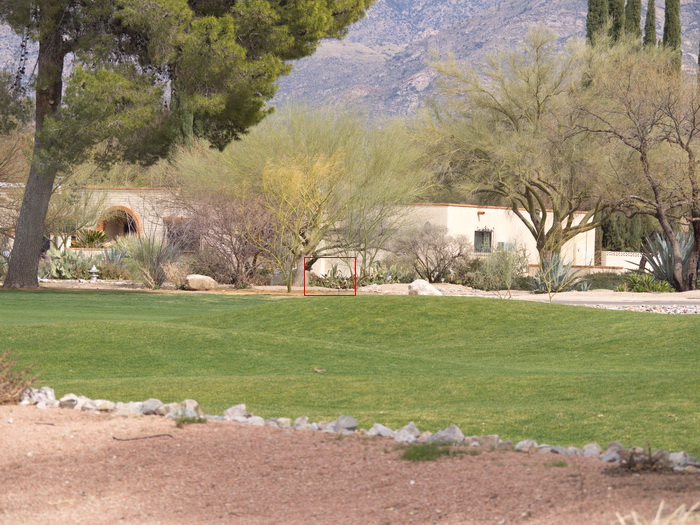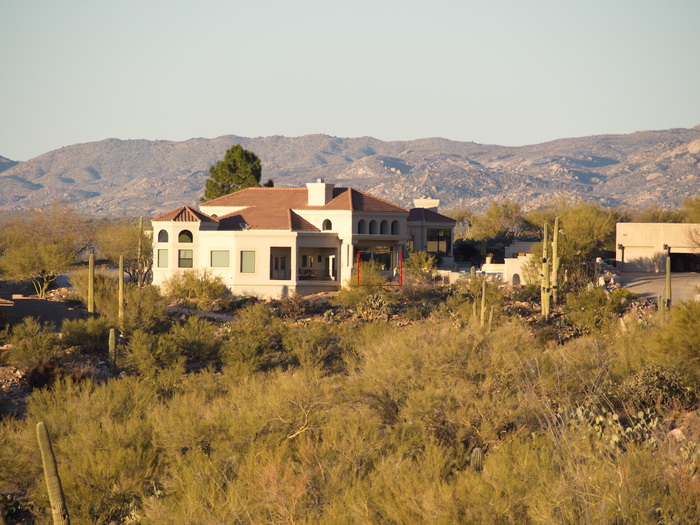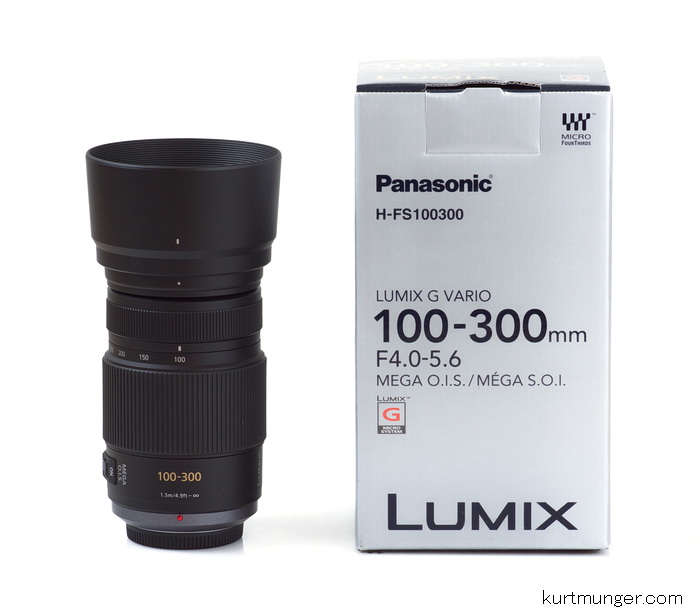 |
| Box and some contents, sorry, left out the carrying bag! |
The Olympus E-M5 was used for this review.
For a better understanding of terms and methods used in this review, go here. The usual center, mid-section and corner crops are located at the very bottom of the page.
Introduction.
The Panasonic Lumix G Vario 100-300mm F/4-5.6 MEGA OIS (Made in Japan) is a very compact and light-weight lens when you consider the area of coverage, which in 135 film format would be a whopping 200-600mm! However, when compared to other MFT lenses, it really is on the large size; in fact, as of this review, it’s the largest Micro four thirds lens! Panasonic introduced the 100-300mm in Sept, 2010. This lens is equipped with ‘MEGA OIS’ which is great, although Olympus camera owners with 5 axis stabilization may wish to turn off the MEGA OIS as the Olympus in-body stabilization seems to work better—do not use both at the same time! The specs for this lens says there is one ‘ED’ element used in its construction.
For use on micro 4/3 mirrorless cameras only.
Fit and finish are good. The lens is clad in high quality plastic, with a single plastic extension tube along with a metal mount. Focus and zoom rings have a ribbed design, but the focus ring is not rubberized for some reason, probably because they don’t expect you to use it.
The zoom action is smooth and damped properly in my opinion, (one finger zooming is possible) and holds its position well, so there is no zoom creep during normal use; which is good as there is no zoom lock. Focal length index marks come at 100mm, 150mm, 200mm, 250mm, and 300mm. The EXIF data matches the 100mm, 150mm and 300mm indices, but 200mm will either read 197 or 201mm, never 200mm. 250mm will read 246mm or 252mm. I’m not sure if this is an issue with all lenses, or a QC quirk.
In the box: the lens, front and rear caps, a petal type plastic hood, carrying bag, (not shown) and owner’s manual.
Focusing. This lens auto-focuses almost silently. Focusing seems quite accurate at all focal lengths, and reasonable quick in good light, especially around 100mm. Near 300mm in low light auto focusing is poor with my camera. Manual focusing requires a lot of ring turning while trying to hold the camera steady, it ain’t easy folks. The front filter ring doesn’t turn when focusing, so your polarizers and grads will work great.
This lens has ‘MEGA OIS’ which is image stabilization built inside the lens, there’s a switch to turn it on and off on the side—see product shots. The Olympus E-M5 has image stabilization that uses sensor shift inside the camera. If you try and use both at the same time, the image in live view or the viewfinder will jump around in an annoying sort of way, that’s your clue that you have both systems turned on. Choose whatever system works the best for you and turn the other one off. I seem to have better luck with the Olympus 5 axis stabilization.
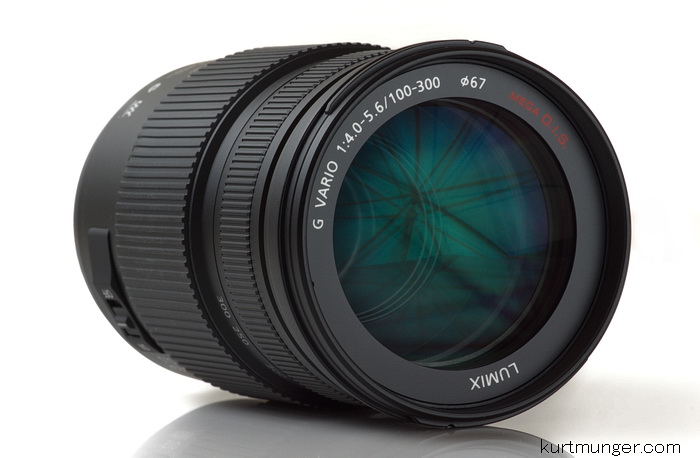 |
| Front |
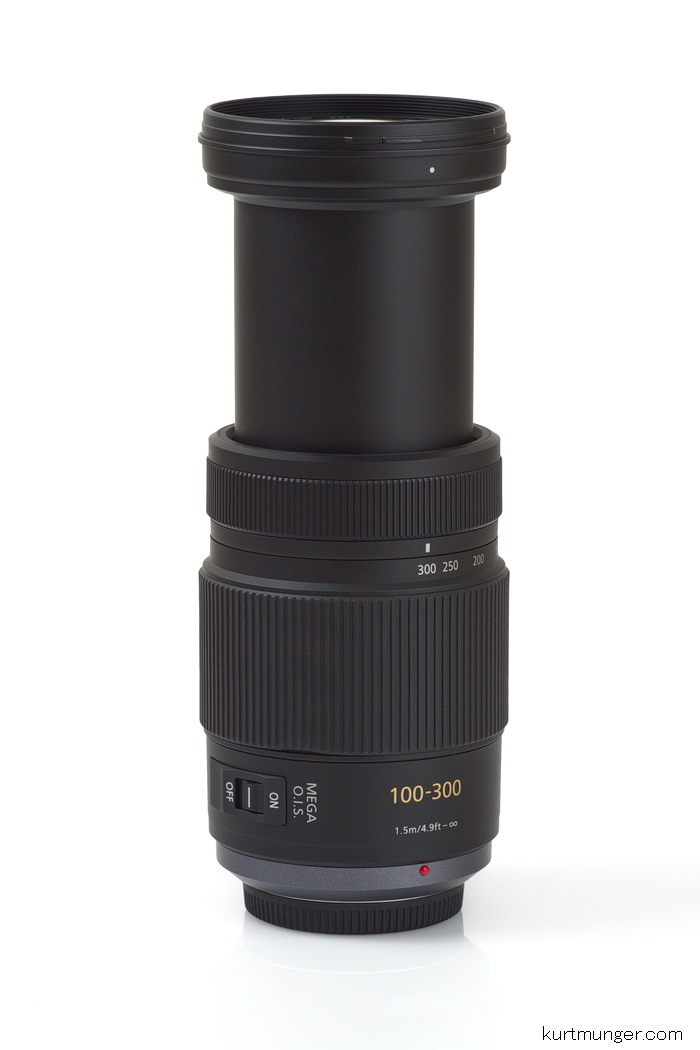 |
| Fully extended. Zoom ring rubber puckered in at one spot. |
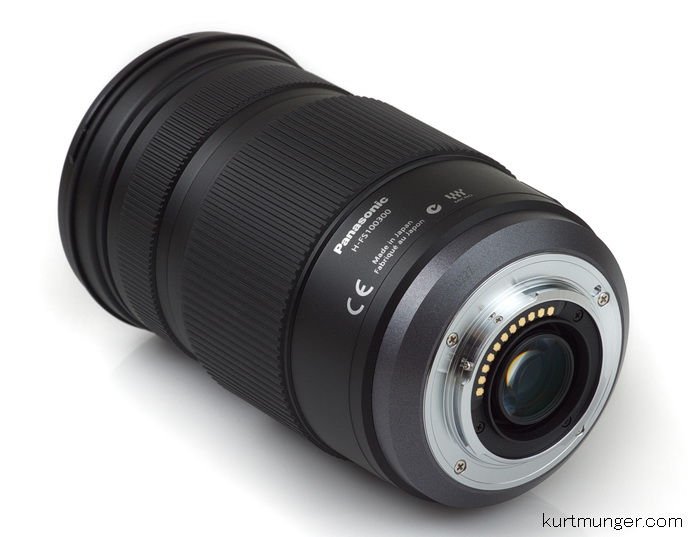 |
| Back |
 |
| Mounted on Olympus E-M5 |
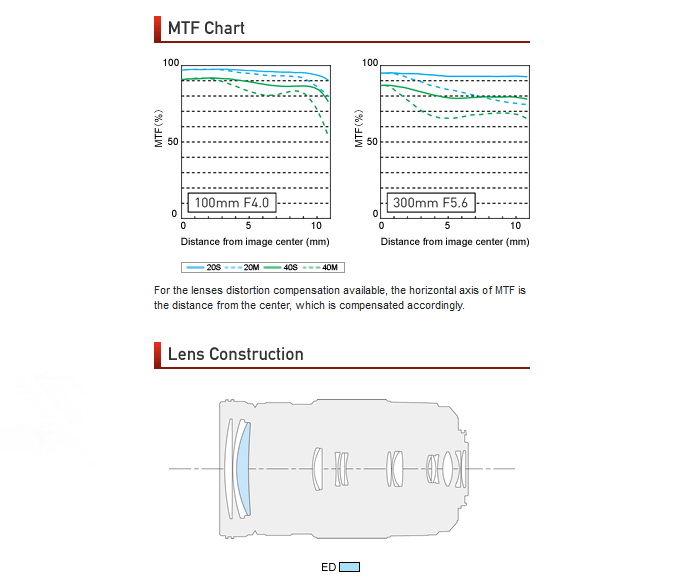 |
| Panasonic MTF graph |
General information and specifications.
|
Lens
|
|
|
Box contents
|
Front and rear caps, carrying bag, and a user’s manual.
|
|
Cost
|
$499 retail as of 3/2013.
|
|
Build quality
|
Good.
|
|
Additional information
|
Single extension tube, and metal mount.
|
|
Specifications
|
|
|
Optical configuration
|
17 elements in 12 groups
|
|
Angle of view
|
12° – 4.1°
|
|
Aperture
|
7 blades, curved
|
| Formats |
Micro 4/3 only. With a crop factor of 2x the coverage equals 200-600mm in 135 film format.
|
|
Depth of field and focus scales?
|
Nothing.
|
|
Min. focus distance, image plane to subject @ max reproduction ratio
|
About 59″ (1.5m)
|
|
Min. focus distance, end of lens barrel to subject @ max. reproduction ratio
|
About 50″ (1.27m)
|
|
Hard stop at infinity focus?
|
No
|
|
Length changes when focusing?
|
No
|
|
Focus ring turns in AF?
|
No
|
|
Filter size
|
67mm
|
|
Filter ring rotates?
|
No
|
|
Distance encoder?
|
Yes
|
|
Max magnification
|
0.21x, or 0.42x (1:2.4) with crop factor, (135 film).
|
|
Min. F/stop
|
F/22
|
|
Factory teleconverter compatible?
|
N/A
|
|
Length changes when zooming?
|
Yes
|
|
Dimensions WxL (my measurements)
|
2.9″ x 4.95″ 73mm x 126mm. Widest at zoom ring.
|
|
Maximum extended length (my measurements)
|
7.2″ (183mm) longest at 300mm.
|
|
Weight bare (my scale)
|
18.1oz (512g)
|
Optical qualities summary.
Lens flare/ghosting. Some large but dull ghosts appear when super bright light sources are close to, or inside the frame. I see mostly magenta and green smudges, see samples below.
Color fringing (CA). Very good control at the short end, (100-150mm), average control as you near the long end. You’ll see some magenta and green/cyan along high contrast edges along the sides of the image, see sample below.
Bokeh. Mostly neutral at all focal lengths, focusing distances and apertures.
Color. Neutral.
Close up filter. N/A.
Coma. None.
Regular filters cause no additional light fall-off at any length.
Filter size is 67mm. Somewhat uncommon for MFT lenses. 77mm filters can be placed over the front element by hand without vignetting.
Distortion. Very low at all focal lengths. Check out the cropped samples below.
 |
| 100mm, uncorrected from RAW file |
 |
| 200mm, uncorrected from RAW file. |
 |
| 300mm, uncorrected from RAW file, no difference. |
Distortion is not a problem with this lens at any focal length. Usually you’re dealing with serious pincushion with a long telephoto zoom lens. There is very little to no in-camera correction applied to jpegs.
Aperture/focal length guide.
|
Maximum aperture
|
F/4
|
F/4.5
|
F/5.0
|
F/5.4
|
F/5.6
|
|
Length
|
100mm
|
150mm
|
200mm
|
250mm
|
300mm
|
In 135 film format, you’re getting a 200mm F/4 lens, 300mm F/4.5, 400mm F/5, along with 600mm F/5.6! Depth of field is slim at these focal lengths and apertures which is a big plus with 4/3 camera users as you can blur out a distracting background.
Light fall-off.
|
100mm F/4
|
100mm F/5.6
|
|
|
|
|
300mm F/5.6
|
300mm F/8
|
|
|
|
Light fall-off is noticeable across the whole frame at maximum apertures, especially near 100mm F/4, and the long end at F/5.6, about a half stop worth. Closing the aperture 2/3 stop brightens the image up. No additional light fall-off problems with the use of regular filters.
Flare and ghosting.
The Panasonic 100-300mm lens produces a typical amount of ghosting, with magenta and green noticeable when the sun is close to, or inside the frame. Contrast degrades at all focal lengths when the sun is inside the image.
Bokeh samples.
|
100mm F/4
|
100mm F/5.6
|
|
|
|
|
300mm F/5.6
|
300mm F/8
|
|
|
|
Bokeh looks pretty smooth at all focal lengths and apertures. Lentil shaped highlights appear along the sides at wide apertures, and can cause ‘swirling’ bokeh, that’s somewhat typical for telephoto zooms. Bokeh is the character of out of focus highlights, and not simply how far out of focus the background is.
Bokeh at close focusing distances
Bokeh looks mostly smooth when you focus on something close, and your background is close too, all lenses will show this to some extent.
Color fringing.
Lateral color fringing (which occurs along the sides of the image and does not go away by stopping down the aperture) is noticeable only towards the middle and long end of the lens. I see moderate amounts of magenta and green/cyan along the windows. The sample was taken from the middle of the left side of the image, at the last 700 pixels. Panasonic camera owners will not need to worry about color fringing as the camera will eliminate it when shooting jpegs. As of this review Olympus has not yet incorporated this into its products, that will change soon.
Let’s check out the close focus capabilities of this lens.
Check out the 100% cropped portion of the full image. The sample shot was taken with the Olympus E-5M 16mp camera, so don’t compare it to others that were taken with 12 or 24mp cameras. The subject is a standard US stamp, 0.87″x 1.0″ or 22mm x 25mm. Also, note the shot was taken as close to the subject as focusing allowed; in this case a very long 50″ (1.27m), measured from the front of the lens barrel to the subject.
This lens has a good reproduction size of 0.42x, (1:2.4) in 135 film format, and it produced a pretty sharp close focus shot at F/8, although contrast is lacking. There is a big sharpness difference between F/5.6 and F/8 at short focusing distances. As a side note; the “1996” on the bottom left of the stamp measures a mere 1mm wide.
 |
| As close as you can get. F/8. click for larger image |
Conclusion.
The Panasonic Lumix G Vario 100-300mm F/4-5.6 is a telephoto zoom lens with the same coverage as a full frame 135 film format 200-600mm lens, however being that it’s a micro 4/3 lens, it’s much smaller, lighter, and less expensive than a full frame lens of equal quality. Overall, the Panasonic turned in a good review, but it does have its limitations.
This lens is quite small and light-weight for the coverage you’re getting, it’s not really that much larger or heavier than a standard F/2.8 zoom (like 16-50mm) for an APS-C camera. The lens feels fairly solid in the hand, but you won’t forget it’s moslty plastic.
Optically, the lens is best at short to medium lengths, from about 100mm to 200mm, where the whole image is pretty sharp at F/5.6. From about 250mm to 300mm there isn’t much of a resolution difference, meaning you could almost upsize a 250mm shot to make it look the same as a 300mm shot; however, if you flip between image crops at those two lengths, you will see a very small increase in resolution with the right type of detail present.
Rehash: Color fringing is not an issue at the short end, but at the long end it is noticeable, but no worse than other telephoto zooms. You can remove this type of color fringing in RAW, and newer Panasonic cameras will do this automatically when saving images as jpegs. Ghosting control is average with the usual green and magenta blobs, and seems to be about the same at all focal lengths. Distortion is controlled well, and is not an issue at any focal length. Close focus quality is pretty good as long as you focus correctly, and stop down to F/8 for flat copy work such as my stamp shot.
For what it’s worth: This telephoto zoom is not a good all-around lens, it’s just too long, meaning the coverage is super tight! Plan on 20′ (6m) or so just to frame a person’s face at 300mm!! It would make a good portrait lens for timid photographers as you could sit on a park bench and take candid portraits from far off. It could also be a useful bird or wildlife lens with adequate light for focusing. In low light, AF is poor at the long end, and manually focusing in low light is tough. All said, the Panasonic 100-300mm performs very well considering the small size and price point. I purchased my review copy and am quite happy with it.
|























